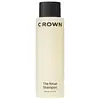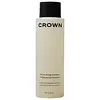What's inside
What's inside
 Key Ingredients
Key Ingredients

 Benefits
Benefits

 Concerns
Concerns

 Ingredients Side-by-side
Ingredients Side-by-side

Water
Skin ConditioningLauramidopropyl Hydroxysultaine
CleansingSodium Laurylglucosides Hydroxypropylsulfonate
CleansingCocamidopropyl Hydroxysultaine
CleansingSodium Cocoyl Sarcosinate
CleansingDisodium Lauryl Sulfosuccinate
CleansingGlycerin
HumectantEthyltrimonium Chloride Methacrylate/Hydrolyzed Wheat Protein Copolymer
Parfum
MaskingCamellia Japonica Seed Oil
EmollientIsodecyl Neopentanoate
EmollientGluconolactone
Skin ConditioningSodium Benzoate
MaskingCalcium Gluconate
HumectantCitric Acid
BufferingWater, Lauramidopropyl Hydroxysultaine, Sodium Laurylglucosides Hydroxypropylsulfonate, Cocamidopropyl Hydroxysultaine, Sodium Cocoyl Sarcosinate, Disodium Lauryl Sulfosuccinate, Glycerin, Ethyltrimonium Chloride Methacrylate/Hydrolyzed Wheat Protein Copolymer, Parfum, Camellia Japonica Seed Oil, Isodecyl Neopentanoate, Gluconolactone, Sodium Benzoate, Calcium Gluconate, Citric Acid
Water
Skin ConditioningCocamidopropyl Hydroxysultaine
CleansingSodium Cocoyl Isethionate
CleansingSodium C14-16 Olefin Sulfonate
CleansingSodium Laurylglucosides Hydroxypropylsulfonate
CleansingSodium Chloride
MaskingCamellia Japonica Seed Oil
EmollientLimnanthes Alba Seed Oil
Skin ConditioningHydrolyzed Rice Protein
Skin ConditioningSodium Hyaluronate
HumectantPanthenol
Skin ConditioningCoconut Acid
CleansingParfum
MaskingSorbitan Oleate Decylglucoside Crosspolymer
CleansingCocamide Mipa
EmulsifyingHydroxyacetophenone
Antioxidant1,2-Hexanediol
Skin ConditioningCaprylyl Glycol
EmollientPolyquaternium-39
Sodium Isethionate
CleansingTetrasodium Glutamate Diacetate
Polyquaternium-10
Cocamidopropyl Dimethylamine
EmulsifyingSodium Benzoate
MaskingSodium Hydroxide
BufferingBenzyl Alcohol
PerfumingPotassium Sorbate
PreservativeTetramethyl Acetyloctahydronaphthalenes
MaskingLimonene
PerfumingJuniperus Virginiana Oil
MaskingLinalyl Acetate
MaskingLinalool
PerfumingPinene
MaskingWater, Cocamidopropyl Hydroxysultaine, Sodium Cocoyl Isethionate, Sodium C14-16 Olefin Sulfonate, Sodium Laurylglucosides Hydroxypropylsulfonate, Sodium Chloride, Camellia Japonica Seed Oil, Limnanthes Alba Seed Oil, Hydrolyzed Rice Protein, Sodium Hyaluronate, Panthenol, Coconut Acid, Parfum, Sorbitan Oleate Decylglucoside Crosspolymer, Cocamide Mipa, Hydroxyacetophenone, 1,2-Hexanediol, Caprylyl Glycol, Polyquaternium-39, Sodium Isethionate, Tetrasodium Glutamate Diacetate, Polyquaternium-10, Cocamidopropyl Dimethylamine, Sodium Benzoate, Sodium Hydroxide, Benzyl Alcohol, Potassium Sorbate, Tetramethyl Acetyloctahydronaphthalenes, Limonene, Juniperus Virginiana Oil, Linalyl Acetate, Linalool, Pinene
Ingredients Explained
These ingredients are found in both products.
Ingredients higher up in an ingredient list are typically present in a larger amount.
Camellia Japonica Seed Oil comes from the Japanese Camellia plant. This plant is native to East Asia and known as "Tsubaki" in Japanese.
Camellia Japonica Seed Oil is rich in oleic acid. This makes it a great emollient. Emollients help soften and soothe the skin by forming a barrier. This barrier traps moisture within, keeping your skin hydated.
Cocamidopropyl Hydroxysultaine is a synthetic cleansing agent, though it is derived from coconut oil.
It is used to enhance the texture of products by boosting lather and thickening the texture. As a cleanser, Cocamidopropyl Hydroxysultaine is mild.
Parfum is a catch-all term for an ingredient or more that is used to give a scent to products.
Also called "fragrance", this ingredient can be a blend of hundreds of chemicals or plant oils. This means every product with "fragrance" or "parfum" in the ingredients list is a different mixture.
For instance, Habanolide is a proprietary trade name for a specific aroma chemical. When used as a fragrance ingredient in cosmetics, most aroma chemicals fall under the broad labeling category of “FRAGRANCE” or “PARFUM” according to EU and US regulations.
The term 'parfum' or 'fragrance' is not regulated in many countries. In many cases, it is up to the brand to define this term.
For instance, many brands choose to label themselves as "fragrance-free" because they are not using synthetic fragrances. However, their products may still contain ingredients such as essential oils that are considered a fragrance by INCI standards.
One example is Calendula flower extract. Calendula is an essential oil that still imparts a scent or 'fragrance'.
Depending on the blend, the ingredients in the mixture can cause allergies and sensitivities on the skin. Some ingredients that are known EU allergens include linalool and citronellol.
Parfum can also be used to mask or cover an unpleasant scent.
The bottom line is: not all fragrances/parfum/ingredients are created equally. If you are worried about fragrances, we recommend taking a closer look at an ingredient. And of course, we always recommend speaking with a professional.
Learn more about ParfumSodium Benzoate is a preservative. It's used in both cosmetic and food products to inhibit the growth of mold and bacteria. It is typically produced synthetically.
Both the US FDA and EU Health Committee have approved the use of sodium benzoate. In the US, levels of 0.1% (of the total product) are allowed.
Sodium benzoate works as a preservative by inhibiting the growth of bacteria inside of cells. It prevents the cell from fermenting a type of sugar using an enzyme called phosphofructokinase.
It is the salt of benzoic acid. Foods containing sodium benzoate include soda, salad dressings, condiments, fruit juices, wines, and snack foods.
Studies for using ascorbic acid and sodium benzoate in cosmetics are lacking, especially in skincare routines with multiple steps.
We always recommend speaking with a professional, such as a dermatologist, if you have any concerns.
Learn more about Sodium BenzoateWe don't have a description for Sodium Laurylglucosides Hydroxypropylsulfonate yet.
Water. It's the most common cosmetic ingredient of all. You'll usually see it at the top of ingredient lists, meaning that it makes up the largest part of the product.
So why is it so popular? Water most often acts as a solvent - this means that it helps dissolve other ingredients into the formulation.
You'll also recognize water as that liquid we all need to stay alive. If you see this, drink a glass of water. Stay hydrated!
Learn more about Water